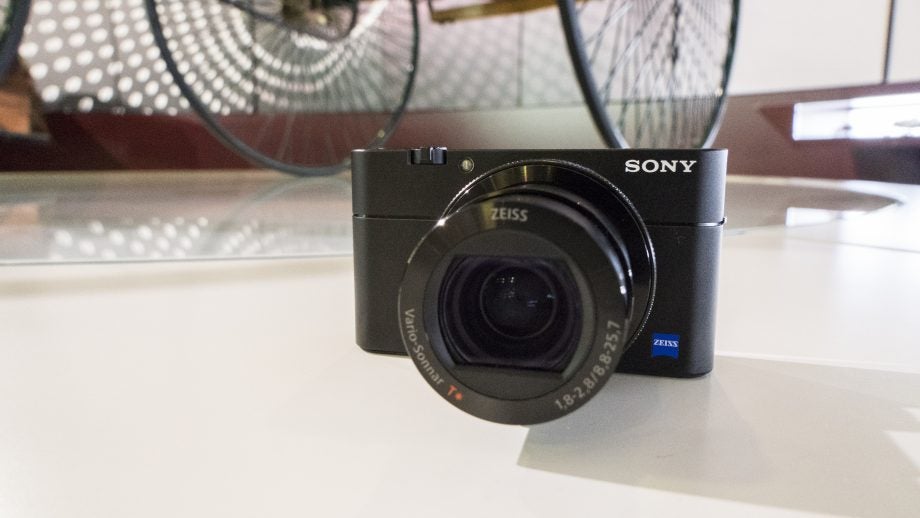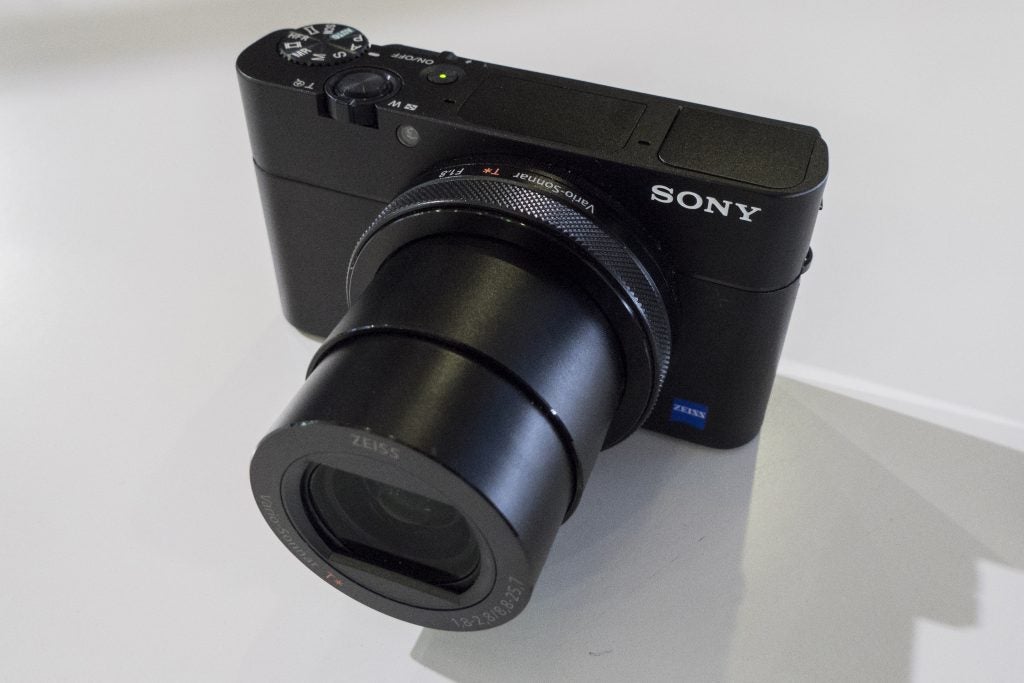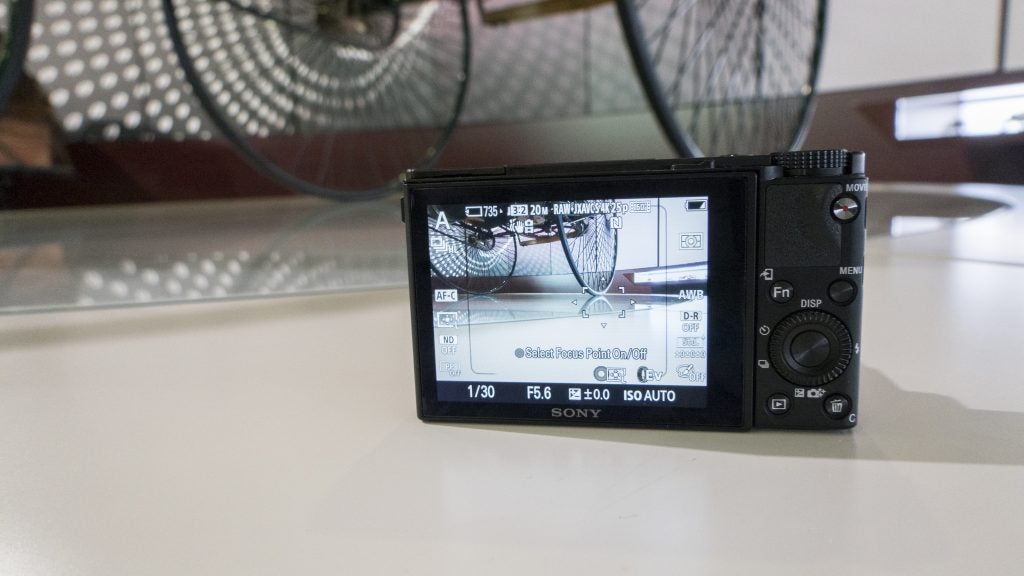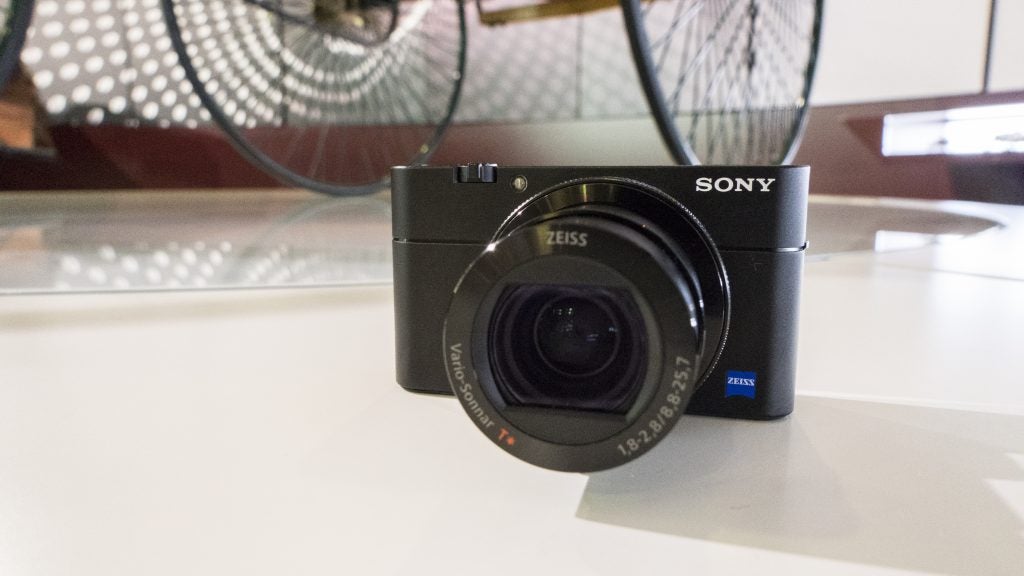Sony RX100 V Review
Sony RX100 V
Sony's premium compact has been succeeded but not necessarily bettered

Verdict
Pros
- Small and lightweight
- Tilting screen
- Built-in electronic viewfinder
- Large sensor
- Fast frame rate
- 4K video recording
Cons
- Very expensive
- Screen not touch-sensitive
Key Specifications
- Review Price: £999.00
- 20.1-megapixel one-inch CMOS sensor with stacked design
- 0.05 sec AF
- 24fps shooting
- Zeiss 2.9x optical zoom (24-70mm equivalent) f/1.8-f/2.8 lens
- 0.39-inch electronic viewfinder
- 3-inch 1,228k-dot tilting TFT LCD screen
- Bionz X processor
- 220-shot battery life
- Built-in Wi-Fi
- 101.6 x 58.1 x 41mm
- 299g (including battery and memory card)
What is the Sony RX100 V?
The RX100 series is Sony’s attempt to make the ultimate point-and-shoot compact with a one-inch sensor.
This fifth instalment from 2016 has since been succeeded, but not replaced, by the Sony RX100 VI. However, with the latter only bringing minor changes beyond its new 24-200mm lens, the RX100 V is still very much worth considering if you’re looking for a premium compact camera – particularly as it costs around £175 less than its newer stablemate.
Rather than the RX100 VI’s 8x zoom, this model has a shorter 24-70mm focal length. The benefit, though, is that its lens has a brighter f/1.8-2.8 range, meaning it’s more comfortable in lower light.
Alongside its 20.1-megapixel, one-inch sensor, the RX100 V has 4K video recording and offers incredibly fast shooting at 24fps (including autofocus too). Combine this with its tiny body and the Sony RX100 V remains one of the best carry-around and vlogging cameras, despite it having an even more advanced successor.
Related: Best vlogging cameras
Sony RX100 V – Design and Handling

From the outside, there isn’t a huge deal to differentiate the RX100 V from its stablemates. Its small, solid body give it a really premium feel.
There’s no grip on the front of the camera, so it might be an idea to always have the hand strap attached to ensure you don’t accidentally drop it. You can purchase an optional grip that can be attached to the front of the camera if you find it too smooth. On the rear of the camera you’ll find a small rubberised thumb rest.
All the buttons on the back of the camera are grouped together on the right to make using the camera easy with just one hand. A mode dial sits on the top of the camera, which you can reach with your thumb for quickly switching between the various modes on offer.
Since the camera is relatively small, there aren’t that many buttons, but those that are present are useful. There’s a circular scrolling dial, with built-in navigational keys. Each of the directional keys has its own function assigned to it by default, but you can change the function of these buttons in the main menu to get the camera to work exactly how you want it.
Particularly useful on the back of the camera is the Fn button. By default, this provides access to the quick menu while in shooting mode. Here you’ll find shortcuts to commonly used settings, such as ISO and white balance. And in further good news, this menu can be completely customised to your preferred settings, allowing you to use the camera exactly the way you like to.
Around the lens ring is a dial that you can use to change different settings, depending on your preference. Every shooting mode has a default setting option for this dial, but you can change it in the main menu if you wish.
The RX100V’s menu system isn’t the simplest to navigate. This is a camera that you’d benefit from sitting down and studying – rather than being out in the field and needing to change a setting and getting lost.
Once you’ve got your head around its quirks, though, it becomes easier to locate features.
Related: Best compact cameras
Sony RX100 V – Screen and Viewfinder

For a camera that costs this much, it’s disappointing that the screen isn’t touch-sensitive.
Sony has finally included a touchscreen for choosing focus points on its RX100 VI, so if that’s important to you it might be worth paying the extra for that version.
With cameras that have an abundance of buttons, or a joystick, the touchscreen isn’t necessarily missed, but in the case of the RX100 V, the lack of one puts a dampener on an otherwise lovely to use camera.
Setting autofocus point would be so much quicker with a touchscreen, as would flicking through images and changing menu settings. It’s notable that the touchscreen on the RX100 VI stops short of letting you do the latter though, which means both fall short of the likes of the Panasonic LX200 in this department.
Still, it is possible to tilt the screen downwards, which is useful for high-angle shots, and you can also position it to use the screen as a waist-level finder, or face it all the way forward for selfies and vlogging to camera.
Unlike most other cameras of this size and type, the RX100 V – like its predecessors – squeezes in a viewfinder. To activate it, you push a switch on the side of the camera, after which you pull it out from its housing – a two-step process that’s a little cumbersome, but nonetheless clever in the way it hides out of the way when you don’t need it.
The viewfinder is quite small, however, but offers a very clear view, and is a decent feature to have when the sun is very strong on the rear screen – or, perhaps, if you simply prefer to compose your images in this way.
If you pop up the viewfinder when the camera is switched off, this action will also activate the camera.
Sony RX100 V – Performance and AF

Autofocusing is one of the key areas that was improved for this version of the camera.
In bright light – when shooting outdoors, for example – it locks onto the target without fuss in 99.9% of instances. When the light drops, focusing remains impressively fast, but can struggle a little if the subject is also low-contrast; it rarely presents a false confirmation of focus, however.
Even more impressive is tracking autofocus, which coupled with the high frame rate of 24fps, means you can capture some split-second action. While this isn’t a camera that will be picked up by sports and action photographers, it’s useful to have a pocket camera that’s capable of tracking a subject for other types of work – including street photography.
The camera’s buffer is extremely impressive, too. You can shoot for around 150 JPEG images before the camera needs to pause, and it can also manage 72 raw format shots – which should be enough to get the decisive moment in most scenarios.
The Bionz processor makes the camera particularly fast in use. Start-up time is around a second, but you may want to leave the camera switched on if you’re taking quite a few spontaneous shots in quick succession. Shot-to-shot time is also super-impressive, with a barely imperceptible pause between shots. Viewing images in playback, and navigating through menus is speedy too.
All the power required for the admittedly impressive specifications has had a negative impact on battery life, however – the rating is now just 220 shots. If you’re planning to be a reasonably frequent user, or just want to ensure the battery lasts the whole day while out on your travels, then a second battery will be essential.
Alternatively, you can charge via USB, so if you have a portable power bank then you could have that on standby.
Sony RX100 V – Lens
Most appealing about the RX100 V is the style of lens with which it’s equipped. Not only does it offer the “traditional” 24-70mm focal length, but it also has a wide aperture, covering f/1.8-f/2.8 throughout the focal range. This remains from the camera’s predecessor.
It’s fair to say that you don’t have to zoom very far to lose that f/1.8 maximum aperture, but only rising to f/2.8 means you’ll never have to use a narrow aperture if you don’t want to.
This is great for both creating shallow depth-of-field effects and for keeping ISO sensitivity lower than you might otherwise need. If you don’t need the Sony RX100 VI’s extra 8x optical zoom, then this brighter lens will most likely be preferable, particularly if you often shoot in low light.
Sony RX100 V – Image Quality

As you’d like to hope from a camera that costs £1,000, image quality is excellent – as is the case with the rest of Sony’s RX100 series of cameras.
Colours are pleasingly saturated, without being too over the top, and there’s a good sense of realism to images. It’s worth experimenting with the different Picture Styles to match the subject, or to suit your personal tastes.
Creative Effects, too, can be fun to try – but note that you can’t shoot in raw format while using them.
Generally speaking, the all-purpose metering does a good job to produce accurate exposures, only needing to dial in exposure compensation in situations we’d expect.
Detail is well rendered, and especially at low ISO settings, the overall impression is fantastic. Looking at an image at 100% reveals plenty of fine detail between ISO 100 and 400. Between ISO 800 and 3200, detail is still impressive, but certain areas of the image can have a slightly more painterly effect – particularly towards the higher end of the scale.
Noise is well controlled up to around ISO 1600, where it’s barely visible at all at normal printing and web sizes. At ISO 3200 it’s a little more visible, but not unsatisfactorily so. At ISO 6400, details start to appear a little smudgy, even when viewing at standard printing and web sizes. Although ISO 12800 is available, noise is reasonably well pronounced, while details can be lost entirely. If you use wide apertures, such as f/1.8 or f/2.8, you may find you never need to use such a high ISO, though.
Shooting in Raw format reveals how much noise reduction is applied to JPEG images – if you look at the equivalent raw format file, you’ll see there’s quite a bit more present. While the noise reduction is applied in a natural way, there’s scope for making your own noise reduction edits if you want to bring out finer detail for certain subjects.
Automatic white balance performs very well to produce pleasingly accurate colours in a variety of different lighting conditions. Under some types of artificial lighting, you might find that auto white balance errs ever so slightly towards yellowish or warm tones. In this case, switching to a more specific white balance can produce greater accuracy if you need it.
It’s worth switching on the dynamic range optimiser, since it helps to balance out exposures where there might be an area of high or low contrast. You can switch it to an automatic setting, or you can choose from several different levels, depending on the situation you find yourself in. The automatic setting does a good job of getting the right balance in most conditions.
Sony RX100 V – Video
Although the RX100 V is capable of shooting 4K video, with full pixel readout and no pixel binning, the fact that it doesn’t have a microphone port or headphone socket means that it’s unlikely to appeal to anybody but casual videographers.
It’s always nice to have video functionality available for on-the-fly movies, though, and the quality on offer here is decent. Focus transitions are smooth and gentle – but again, a touchscreen would have made it easier to quickly move the point to where you need it.
If you plan to record in 4K video, you’ll need a UHS – I U3-compatible memory card – or you can choose to record in another format, such as Full HD. You might also want to consider switching to Full HD to save memory card space, depending on the importance of the video you’re creating.
Should you buy the Sony RX100 V?
There’s no doubt that just under £1,000 is a lot to spend on a compact camera, particularly one that has since been succeeded by the (even more expensive) RX100 VI.
This version of the RX100 series, though, remains something of a sweet spot for the range, combining fantastic technology like 4K video recording and 24fps shooting with a bright, 24-70mm lens.
Depending on what you like to shoot, you may be better off with an even earlier version of the RX100 series like the RX100 IV. For example, if you rarely shoot fast-moving subjects, then you may be able to live without its high-frame-rate shooting.
If you need longer zoom, it’s also fair to say that the Panasonic TZ100 and TZ200 remain much better value too. But if you generally prefer to shoot at closer range and want the pinnacle of compact camera tech in an ultraportable package, then the RX100 V is still a very fine choice – and at £175 less than the RX100 VI, perhaps an even better buy than its successor.
Verdict
The RX100 V remains one of the best small-sized compact cameras on the market. Only the lack of a touch-sensitive screen, poor battery life, and that extremely high asking price see it fall short of perfection.
Trusted Score
Score in detail
-
Value 6
-
Features 8
-
Image Quality 9
-
Build Quality 9
-
Performance 9

